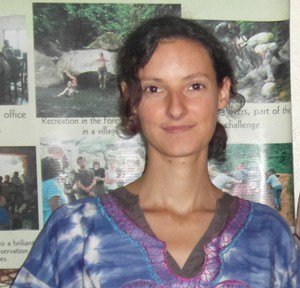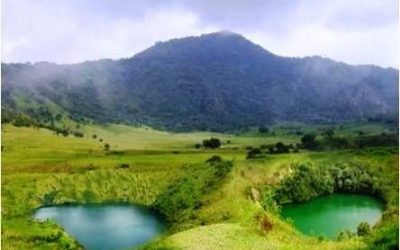The Environment and Rural Development Foundation (ERuDeF) is proud to announce the recruitment of its 2014 Volunteers to take part in the Cross River Gorilla and other great apes Expedition in the Lebialem Highlands SW Cameroon. Since 2008, ERuDeF has recruited over 300 Volunteers from different parts of the globe. These volunteers have visited the dense tropical rainforest in the Lebialem Highlands to track the Cross River Gorillas and other great apes. As 2014 approaches, the organisation is launching the next search for volunteers to get the chance of experiencing the African rain forest. Volunteer with us today and save a Cross River Gorilla. Find below the various dates available to volunteer with us for 2014.
IVP DATES FOR 2014
a) The six weeks volunteering programme
1) January 12, 2014
2 February 9, 2014
3 March 9, 2014
4 April 13, 2014
5 May 11, 2014
6 June 8, 2014
7 July 13, 2014
8 August 10, 2014
9 Sept.14, 2014
10 Oct. 12, 2014
11 Nov. 9, 2014
February 23, 2014
March 23, 2014
April 20, 2014
May 25, 2014
June 22, 2014
July 20, 2014
August 24, 2014
September 21, 2012
October 26, 2014
November 23, 2014
December 21, 2014
b) The One Month Volunteering Programme
DATE OF ARRIVAL AND DEPARTURE
1 January 12, 2014
2 February 9, 2014
3 March 9, 2014
4 April 13, 2014
5 May 11, 2014
6 June 8, 2014
7 July 13, 2014
8 August 10,2014
9 September 14, 2014
10 October 12, 2014
11 November 9, 2014
12 December 14 2014 (Departure Date Only)
The two week volunteering programme
1 January 12, 2014
2 February 9, 2014
3 March 9, 2014
4 April 13, 2014
5 May 11, 2014
6 June 8, 2014
7 July 13, 2014
8 August 10,2014
9 Sept. 14, 2014
10 Oct. 12, 2014
11 Nov. 9, 2014
January 26, 2014
February 23, 2014
March 23, 2014
April 27, 2014
May 25, 2014
June 22, 2014
July 27, 2014
August 24, 2014
September 28, 2014
October 26, 2014
November 23, 2014
The aim of this program is to promote awareness and protect the Cross River Gorillas and other globally protected species in the Lebialem Highlands. The IVP has two main components namely: Gorilla tracking; during tracking, key observations include sighting of nesting sites, direct sighting, vocalisation, feeding signs and moving tracks of apes are recorded. Conservation education is equally another aspect of the IVP program whereby the Volunteer gets to partake into school and community conservation education. The different Forest areas that Volunteers for ERuDeF visit include but not limited to
1) PROPOSED TOFALA HILL WILDLIFE SANCTUARY
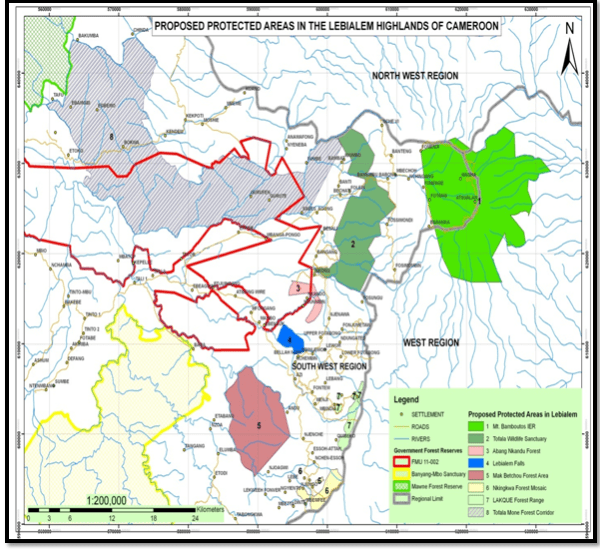
The area harbors two great apes species: the critically endangered Cross River gorillas (Gorilla gorilla diehli) and the most endangered subspecies of the African chimpanzees (Pan troglodytes ellioti) (Oates et al, 2007 and Bethan et al 2010). Other large mammals found within this site include: Drills (Mandrillus leucophaeus) endemic to this region, Bush baby (Peridicticus pottos), Putty-nosed monkey (Cercopithecus nictitans) and the Red-eared monkey (Cercopithecus erythrotis). Also, this area has a viable population of some globally threatened species of birds which inclue: Bannerman’s turaco (Turaco bannermani), Banded wattled-eye (Plastysteira laticincta), Cameroon Montane Greenbul (Andropadus montanus), Bannerman’s weaver (Ploceus bannermani), Red headed Picathartes (Picathartes gymnocephalus), Green Breasted Bush-Shrike (Malaconotus gladiator) and Bangwa forest wabbler (Bradypterus bangwaensis).
About 19 villages are adjacent this area, some of which include: Bamumbu, Igumbo, Banti, Folepi, Bechati, Besali, Bangang, Nkong and Fossimondi. Socio-economic activities in these villages are focused on forest exploitation such as: farming (with principal crops being palms, plantain, and cocoyam), hunting/poaching of wildlife species, and harvesting of Non Timber Forest Products (NTFPs). They are also involved in aspects of petty trading, minor scale fishing, and local crafting like weaving of local baskets for income generation.
2) BECHATI-MONE FOREST CORRIDOR
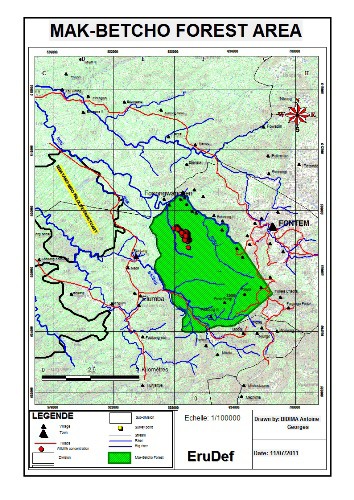
It lies within the equatorial rainforest zone characterized by two (2) major seasons; the dry season (Nov-Feb) and the wet season (Mar-Oct), with the peak in August. Its altitude ranges from 130 to 1200 m a.s.l, giving rise to two broad vegetation types; the lowland forest and the sub-montane forest. This vegetation accounts for the huge flora and fauna diversity of the area.
Large mammals found in the site include two species of great apes; Cross River gorilla (Gorilla gorilla diehli), chimpanzee (Pan Troglodytes vellerosus), which are critically endangered and endangered respectively. Other large mammals found in the site include: forest buffalo (Syncerus caffer), the bay duiker (Cephalophus dorsalis), peter’s duikers (Cephalophus callipygus), the white-nosed monkey (Cercopithecus nictitans), Mona monkey (Cercopithecus mona), red tailed monkey (Cercopithecus ascanius) and the red river hog (Potamochoerus porcus).
So far about 28 villages are adjacent this forest site, some of which include: Kugwe, Anemafon, Nyeneba, Fumbe, Ewa, Etuko Mile 22, Nchinda, Kekpoti, Numba, Ditche 1, Ditche 2, Bokwa and Kendem. Socio-economic activities of the people surrounding this forest include: farming (with principal crops being cocoa and plantain), hunting of wildlife species for subsistence and commercial purposes, collection of Non Timber Forest Products. They are also involved in large scale fishing, petty trading and palm oil production for commercial reasons.
3) Mak-Betchou Forest Block (ANDU Forest Site)
The Mak-Betchou Forest Block constitutes one of the six forest blocks that make up the Lebialem-Mone Forest Landscape. It is located within the UTM Grid Zone 32, specifically between the longitudes 586000m and 596000 m and 598000m and 606000m, with a surface area of about 22,000 hectares.
This area also lies within the Equatorial rainforest zone characterized by two (02) main seasons; two (2) major seasons; the dry season which runs from November-February and the wet season which runs from March-October, with the peak rainfall in the August. The annual rainfall recorded in the area is as high as 3500mm (Gartlan, 1989). Its altitude ranges from about 300m to about 1400m a.s.l. This altitudinal variation gives rise to two main types of vegetation: the lowland and the Sub montane forest which makes this area unique in terms of flora and fauna diversity.
Great ape species found in this area include the Nigeria-Cameroon Chimpanzees (Pan Troglodytes ellioti), the most endangered of the African Chimpanzee. Other large mammals found in this area include: the forest elephant (Loxondata africana), Drills (Mandrillus leuceuphaus), Bush baby (Potto), Blue duiker (Cephalophus monticola), Red River hog (Potamochoerus Porcus), Red eared monkey (Cercopithecus erythrotis) and Mona monkey (Cercopithecus mona). Also, this area is a home to some globally threatened species of birds such as: the Cameroon Montane Greenbul (Andropadus montanus), Crossley’s Ground thrush (Zoothera prince), Bangwa forest warbler (Bradypterus bangweasis), Green breasted bush shrike (Malacontus cruentus) and Red headed picathartes (Picathartes oreas).
About 15 villages are adjacent this forest block, some of which include: Essoh Attah, Njorgwi, Lechataw, Minka, Andu, Fotabong II, Fotabong III, Njentse and Ngoh. These communities depend on the forest and its resources for survival. The main activities of the local people inhabiting the adjacent communities include: farming (with principal crops being cocoa), hunting, fishing and collection of Non-Timber Forest Products especially the bush mango (irvingia gabonesis).
Eco Tourism in Cameroon
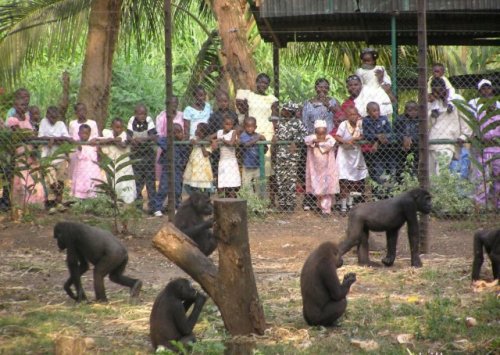
Apart from visiting the rainforest, the volunteer equally has the opportunity of visiting some of the luxurious tourist sites in the country including the Limbe Wildlife Center which harbours 300 animals in captivity including 49 Chimpanzees, 16 gorillas, 93 drills, 15 mandrills, 14 baboons, just to name these. The Volunteer would equally get a chance to spend a cozy time along the black sandy beach of the Atlantic ocean. Depending on the choice of the Volunteer, S/he can also take a trip to some of the beautiful historic sites of the country and visit rare sites like the Lake Awing in the Northwest region and the beautiful white sandy beach of Kribi.
Thrilling Testimonies from Volunteers



